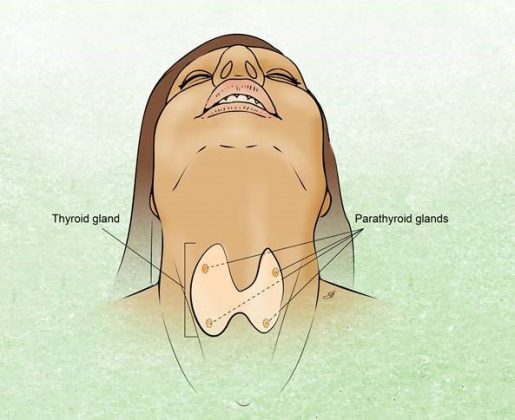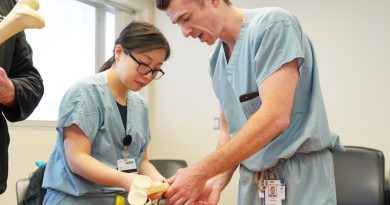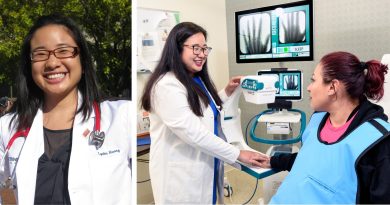Surgery and Thyroid Cancer: What you need to know
The thyroid gland plays a major role in the body’s metabolism, growth and development. Since an estimated 12% of the U.S. population will develop a thyroid condition during their lifetime, raising awareness of thyroid issues, including thyroid cancer, can lead to prompt diagnosis and appropriate management.
Dr. Feibi Zheng, assistant professor of surgery in the Division of Surgical Oncology at Baylor College of Medicine, shares insights about when surgery might be needed for thyroid conditions.
Q: When does a patient need to see an endocrine surgeon about a thyroid problem?
Generally, when we see patients in surgery it is because they’ve discovered a nodule, which is overgrowth of tissue within the thyroid. There are different categories of nodules, and surgeons tend to get involved if a nodule is suspected to have cancer or the nodule has grown so large that it is causing swallowing or swallowing difficulties. The management of thyroid nodules and thyroid cancer is becoming very complex but in a good way, as treatments are tailored to the patient’s risk factors, family history, molecular profile and other preferences.
We also see surgical patients with hyperthyroidism. These are patients with a thyroid that is overproducing thyroid hormone and medication is not adequately controlling the over-production, or the patient needs to get off the medication because of unwanted side effects.

Q: What do I need to do if I feel a lump in my neck?
The first step is to see your primary care doctor. They will perform an exam and if the “lump” is within your thyroid, they will order blood tests to check your thyroid function and a thyroid ultrasound to look at the nodule. Depending on the size of the nodule and how suspicious it looks, you may be sent for a biopsy of the nodule. Some nodules, typically those that are smaller than 1 centimeter or nodules that are completely filled with fluid, may not require a biopsy and can be monitored over time.
Q: What can the nodule be?
Most of the time, if your thyroid nodule biopsy returns with benign tissue, then the nodule does not need to be removed surgically unless you are having problems with swallowing or breathing that are related to the nodule. If the nodule returns as cancer or suspicious for cancer, then we recommend taking out at least half of your thyroid. At that point, we will carefully look at the other side of the thyroid as well as the surrounding lymph nodes to make sure that the cancer has not spread beyond the nodule. Sometimes, the biopsy will be indeterminate, meaning that the cells look abnormal, but we cannot confidently call it cancer or benign. In that situation, you can decide whether you want to repeat the biopsy and send the sample for molecular testing. In molecular testing, we look for mutations within the nodule’s genetic material that predict thyroid cancer. In general, if you don’t have any mutations, your risk of cancer drops back down to less than 5%. Some patients will want to have more peace of mind and know for sure that the nodule is not cancer or don’t want to keep watching the nodule in the future, and in those situations, it is reasonable to have surgery to remove the half of the thyroid with the indeterminate nodule.
Q: Who is most at risk for thyroid cancer?
A: Almost all of the endocrine diseases, including thyroid issues, affect women more often than men. Obesity and diets lacking iodine are associated with thyroid cancer. We also see differences in detection patterns in countries that have aggressive screening programs. Currently, we don’t recommend screening the general population for thyroid cancer. Screening is done for high-risk populations, which include people with genetic syndromes, a history of high levels of radiation to the neck or a family history of thyroid cancer.
Q: Is it treatable?
A: Thyroid cancer is very treatable. While there are rare variants that are very aggressive, the vast majority tend to grow very slowly. Historically, it was difficult to determine how aggressive thyroid cancer would be in a patient, so there was a pattern of “overtreating” the disease. But now we have many tools available that can help us during the diagnosis process. An example is molecular testing, which allows us to look at the genetic footprint of the tumor and offers guidance on how aggressive it will be. In our approach to treatment, we work very closely with our endocrinology, pathology and nuclear medicine colleagues to create a personalized, multidisciplinary plan for each patient.
Additional Resources
To schedule an appointment, call (713) 798-2262 or visit our healthcare site.
-By Bertie Taylor, senior writer in the Michael E. DeBakey Department of Surgery at Baylor College of Medicine



